Discover how recent deep-water surveys in Scottish seas have allowed our Curator of Marine Invertebrates to collect over 1000 specimens of fish and invertebrate specimens for National Museums Scotland’s collections.
Some people may find it surprising that Scotland’s seas still harbour species new to science, but this is undoubtedly true. Since graduating as a marine biologist in 1993, my work has focussed particularly on invertebrates from intertidal and shallow subtidal habitats in Scotland. In hindsight, I have not given much thought to the extraordinary wildlife living just a little further from our shores. Although there are an estimated four million marine specimens in the Natural Sciences collection at National Museums Scotland, the collection has a similar bias. So the opportunity to join two offshore research cruises in 2019 was unmissable both personally and professionally!
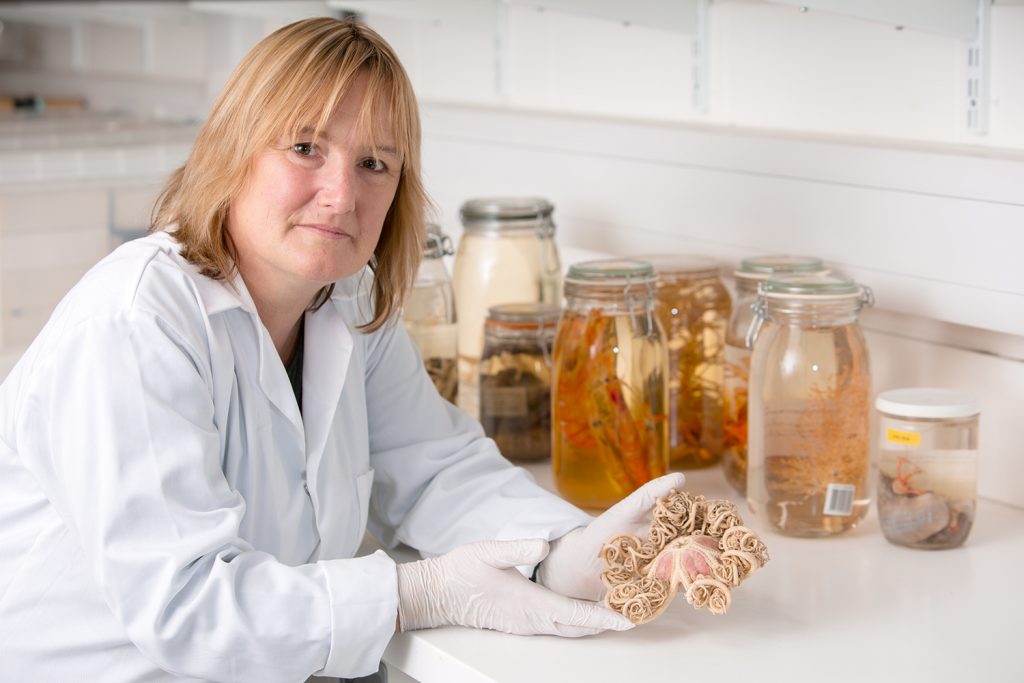
MRV Scotia, Scotland’s main research vessel was used for both of the deep-water research surveys. It operates from the port in Aberdeen, and in August 2019 I joined a team from the Joint Nature Conservation Committee and Marine Scotland Science for the sixteen-day survey of a 4,000 square kilometre area of seabed known as the West Shetland Shelf. This area lies to the north of Scotland in depths of 70 to 150 metres and was designated a Nature Conservation Marine Protected Area (MPA) in 2014, to protect its wide variety of sand and gravel habitats. The stated aim of the survey was to gather data to monitor the condition of the MPA’s designated habitat and associated fauna. This was done by lowering video cameras to film the seabed, and by collecting sediment samples (and their small burrowing inhabitants) with a special grab sampler.
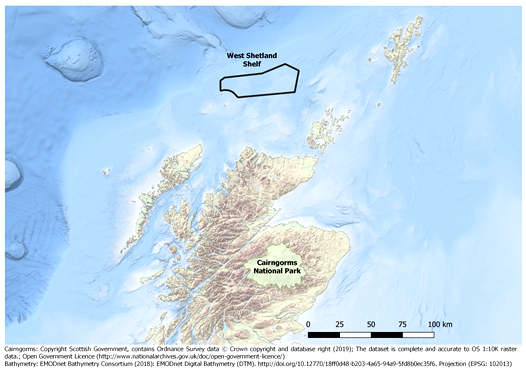
Two weeks later I re-joined MRV Scotia and Marine Scotland scientists for a fourteen-day survey of the continental shelf-slope to the west of the Hebrides. This was part of a biannual survey programme to map and monitor the composition, distribution and abundance of bottom-living and semi-pelagic fish. The main survey area extends from Donegal to the Flannan Isles and despite some minor disruption from the after-effects of Hurricane Lorenzo, we were able to extend the survey to the Faroe-Shetland Channel where the influence of Arctic waters has a marked effect on species composition.
The West Shetland Shelf grab samples were washed through a one-millimetre sieve on board, then the residue was sorted and identified. Failed grab samples (less than five litres of sediment collected), were used to select specimens for sequencing at the Natural History Museum’s Molecular Collections Facility and for the National Museums Scotland collection. Polychaetes dominated the fauna but cup corals, tusk shells, amphipods and brittle stars were also common.
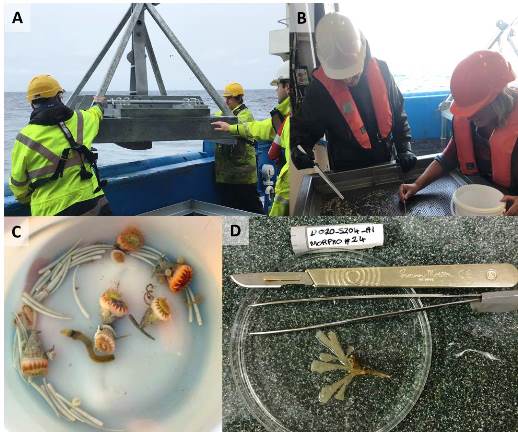
A new species of polychaete (Ampharete oculicirrata) was collected from the area in 2017 and this type of specimen is now housed in National Museums Scotland’s collection. Ampharete is a tube-dwelling worm that feeds by gathering particles of detritus with delicate thread-like tentacles and one of its peculiarities is that it has eyes near its anus as well as on its head. This rarely sampled site could produce further new species and a voucher collection of every species collected during the survey will be deposited with the museum. This will contribute to the publicly accessible reference source for future research on marine fauna and provide part of the baseline for the assessment of change caused by climate change or other factors.
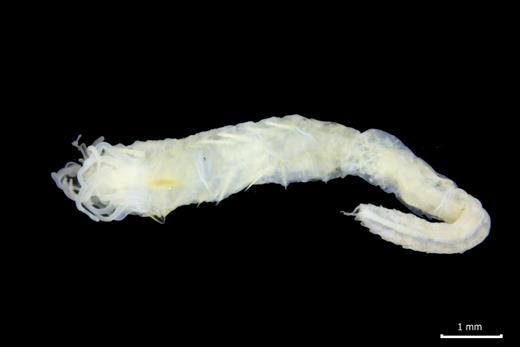
The second survey was dominated by mobile fish which were sorted into separate species, measured and weighed to allow calculation of catch indices and comparison with previous years. Over 150 species of fish were caught and the diversity of form was truly astonishing.
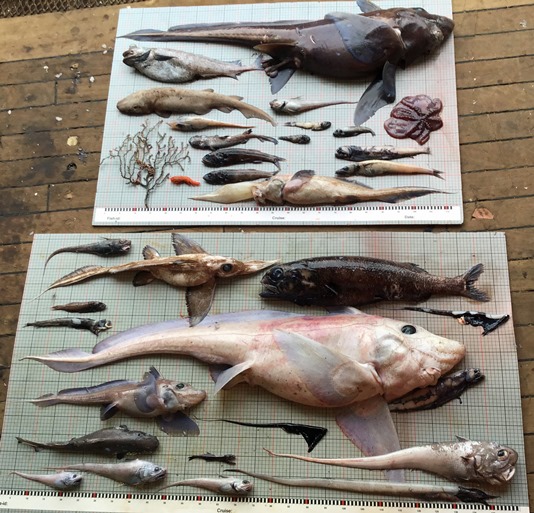
Common features of the fish were light-emitting organs and large eyes for the detection of bioluminescence. Some had grotesquely large mouths to accommodate any size of prey they might encounter, and the jaws were commonly armed with ferociously hooked teeth to prevent the escape of any such prey. A representative collection of 285 fish specimens were frozen onboard the MRV Scotia, before being transferred to National Museums Scotland for long-term preservation.

The invertebrates included crustaceans and a range of large and sparsely distributed animals from the surface of the seabed. Over 800 specimens were retained for National Museum Scotland’s collection. This included species that previously had been absent or under-represented and stunning, display-quality individuals. My highlights included parasitic barnacles and copepods, large isopods and pycnogonids, impressively armoured amphipods, basket stars and vibrant deepwater shrimps.

This material will be meticulously processed and incorporated into the collection for the benefit of current researchers and future generations of marine scientists. Some of these specimens appear in our Scotland’s Precious Seas display, which is on display at the National Museum of Scotland until 10 January 2021.

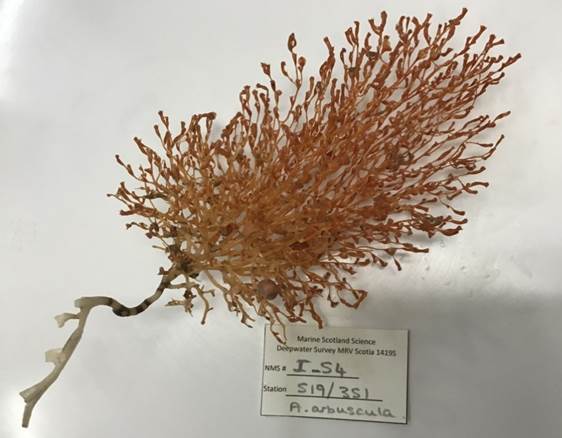
Acknowledgements
Thank you to the Joint Nature Conservation Committee, particularly Joey O’Connor, for the invitation to join the West Shetland Shelf Survey; to Marine Scotland Science, particularly Jim Drewery, for the opportunity to join the Deepwater Survey; and to all the crew and scientists of MRV Scotia Cruises 1219S and 1419S for such enjoyable, productive and enlightening opportunities to develop the collection at National Museums Scotland.
